Dynamic test benches for gear units, couplings and gears in a mechanically closed loop: Airbus Helicopters uses Rotodiff technology to substantially reduce energy consumption
To test whether your mechanical drive systems meet the stringent requirements related to quality, reproducibility and safety, helicopter manufacturers around the world rely on a technology manufactured in Switzerland:
As the heart of dynamic test benches, the ROTODIFF solution from Viscotherm (Fig. 1) guarantees that these test benches can be operated with a fraction of the turbine power. In addition, in this way, gear units can be tested at various gear ratios under the stipulated operating conditions. In addition, dynamic test benches with the Rotodiff can be operated in a mechanically closed loop, which substantially reduces energy consumption.
In back-to-back dynamic test benches in a mechanical closed loop, the input shaft and output shaft of the test object are connected to a gearbox of the same design such that there is mirror symmetry. Then, both are accelerated until they reach the nominal rotational speed and kept at this level when idling. Then, torque is introduced into the drive circuit, which causes the gearboxes to torque against each other. The elastic deformation of the test object and test bench creates a torque angle between the laden and unladen design. Testing is only carried out at a fraction of the nominal power of the gearbox as only the idle power and power loss have to be provided after the nominal rotational speed has been reached (Fig. 2). As a result, a helicopter manufacturer, during the annual gearbox tests at its factory, generates enough power to provide energy to an average town with 30,000 residents (Fig.5).
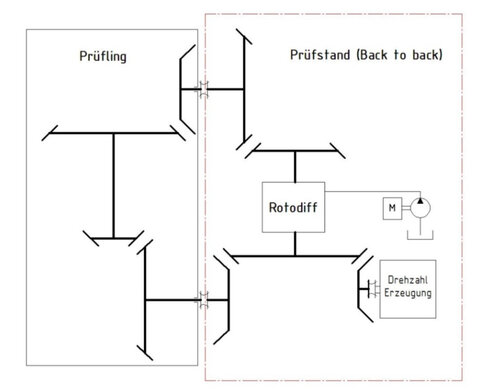
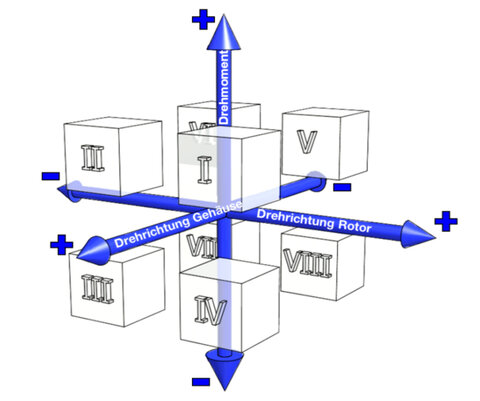
Flexible adaptation to all load cases and gearbox types
In order to enable tests with various gearboxes for helicopters, Rotodiff units have been tried and proven for introducing torque on these types of test benches. In combination with a device for adapting the test bench geometry to the respective input and output shafts of various gearbox types, a universal test environment is created by balancing the differential speed. In addition, the oil volume flow is controlled by a hydraulic unit and adapted to the respective gear ratios or gear reduction. In this process, the housing and rotor of the hydraulic motor, and the differential speed between the two is always proportional to the volume flow (Fig. 3). As the test bench and test object are torqued against each other, the torque is proportional to the pressure and controlled hydraulically. This hydraulic solution enables complete elimination of vibrations. Depending on the design size, the housing reaches rotational speeds up to 6500 rpm, while the differential speed of the rotor can be between ±0.5 and ±200 rpm – at a torque of up to 100,000 Nm. Using the Rotodiff, it is also possible to adapt the rotational direction of the housing and rotor to the gearbox to be tested (Fig. 4).
Here, the gearbox is secured against overloads using a pressure relief valve. Combining various variables creates a flexible dynamic test bench, which enables tests of various gearbox variants at high levels of torque and various frequencies and minimal current consumption. For example, in collaboration with Viscotherm, Airbus Helicopters developed its test bench technology all the way to the latest generation of multipurpose test benches.
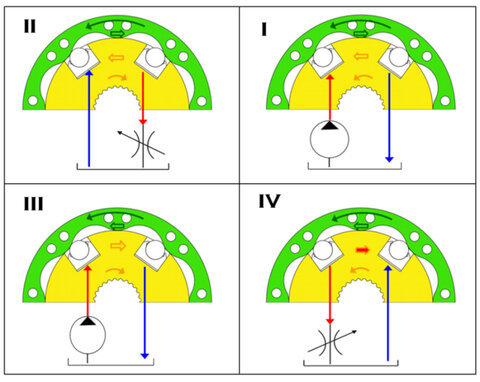
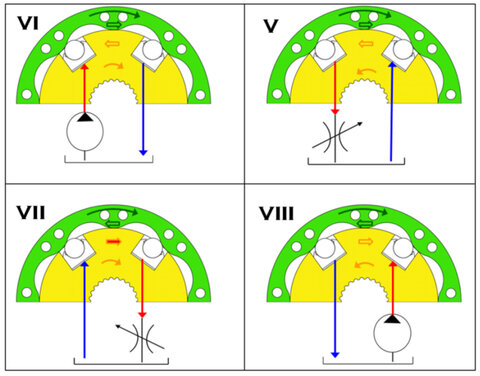
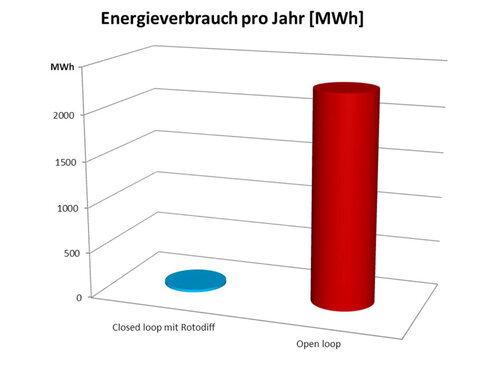
Motor or pump, leading or lagging rotor
To illustrate the function of the Rotodiff, it is divided into eight operation quadrants that can be viewed individually and illustrated with their respective hydraulic circuit (Fig. 4). In quadrants I, III, VI and VIII, the Rotodiff functions as a hydraulic motor: the hydraulic power fed in by a high-pressure pump is converted into torque and rotational movement. In quadrants I, III, VI and VIII, however, the Rotodiff operates as a pump: the physical force exerted on the rotor or shaft is converted into hydraulic power.
Here, the rotor rotates slower than the housing, so it is lagging, whereas in quadrants I, IV, VI and VII, the rotor runs faster than the housing, so it is leading. In quadrants VI and VIII, the drive torque has to be introduced at the rotor. A rotor or housing is available for selection in II and V. Using these switching options, back-to-back test benches can be tailored to a wide variety of kinematic conditions of the test objects. In addition, the desired load parameters can be achieved easily through hydraulic control.
Thanks to the variety of adaptation options of kinematics, their durability and a high level of efficiency, Rotodiff units have proven themselves in dynamic test benches around the world. In addition, the compact and simple design of the units cuts infrastructure costs. An additional advantage is the energy balance, which is lower than it is in equivalent electromechanical test benches. Therefore, the compact Rotodiff of Viscotherm is a great efficient solution to use anywhere where the very large rotation angle or rotational speed adaptations are required for energy-optimised testing of rotary components under highly precise and flexibly controllable parameters.

